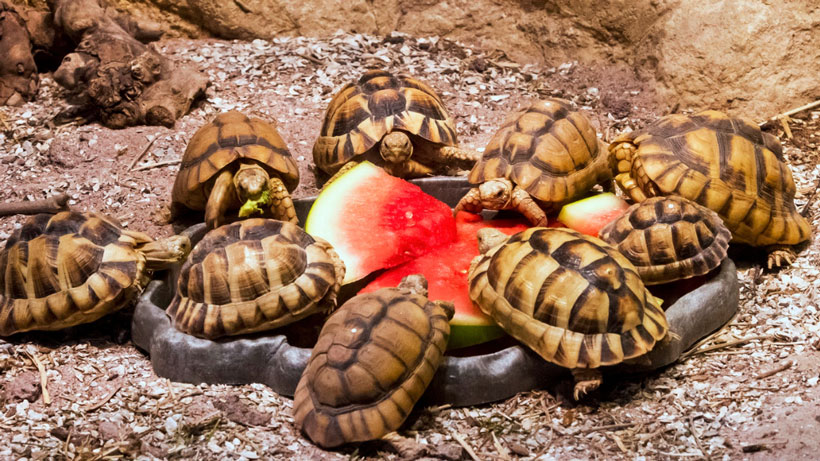7 Smallest Tortoise Breeds That Stay Small
If you’re looking for a pet tortoise that stays small in size, there are several breeds that fit the bill. These diminutive tortoises make great companions for those with limited space or seeking a low-maintenance pet.
So what are those smallest tortoise breeds that stay small? Here are seven of the smallest tortoise breeds renowned for their small stature:
- The Egyptian tortoise
- The Russian tortoise (Horsfield’s tortoise)
- Hermann’s Tortoise
- The Greek tortoise
- The Indian star tortoise
- The pancake tortoise
- Speckled Padloper tortoise (Homopus signatus)
Despite their small size, these tortoises still require proper care and suitable habitat to thrive. With their unique charm and manageable size, these small tortoise breeds can bring joy to tortoise enthusiasts of all ages. Read on as we discuss compactly on each of them.
Are There Tortoises That Don’t Grow Big?
Contents
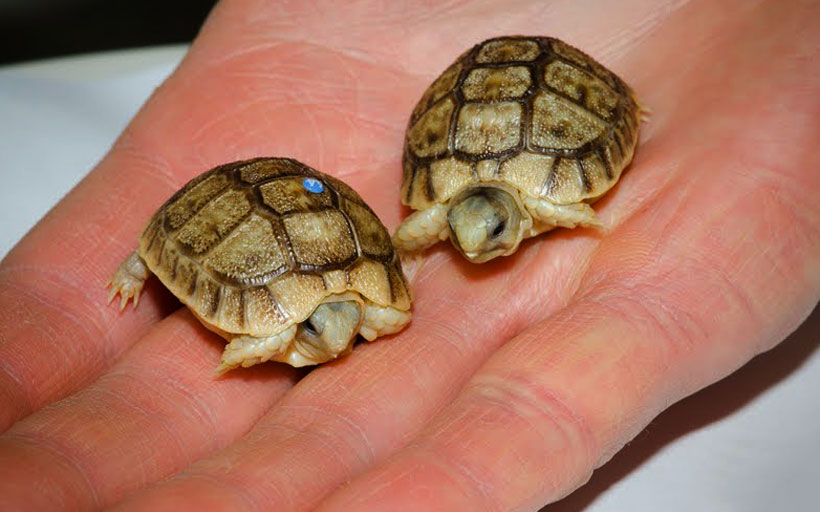
Yes, there are tortoise species that generally remain small in size throughout their lives. These tortoises are known as dwarf or miniature tortoises. They are naturally small and do not grow as large as some of the larger tortoise species. Some examples of tortoise species that tend to stay small include:
| Tortoise Breed | Average Size/Weight |
|---|---|
| The Egyptian tortoise (Testudo kleinmanni) | 3 to 5 inches/ 105 to 400 grams |
| The Russian tortoise (Testudo horsfieldii) | 5 to 10 inches/ 300 to 1500 grams |
| The Greek tortoise (Testudo graeca) | 4 to 9 inches/ 2 to 4 pounds |
| The Hermann’s tortoise (Testudo hermanni) | 5 to 9 inches/ 3 to 4 kg |
| Indian star tortoise (Geochelone elegans) | 5 to 12 inches/ 1.5 to 2.5kg |
| The pancake tortoise (Malacochersus tornieri) | 6 to 7 inches/ 1 pound |
| Speckled Padloper tortoise (Homopus signatus) | 2.4 to 3.1 inches/ 95 to 160 grams |
7 Smallest Tortoise Breeds That Stays Small
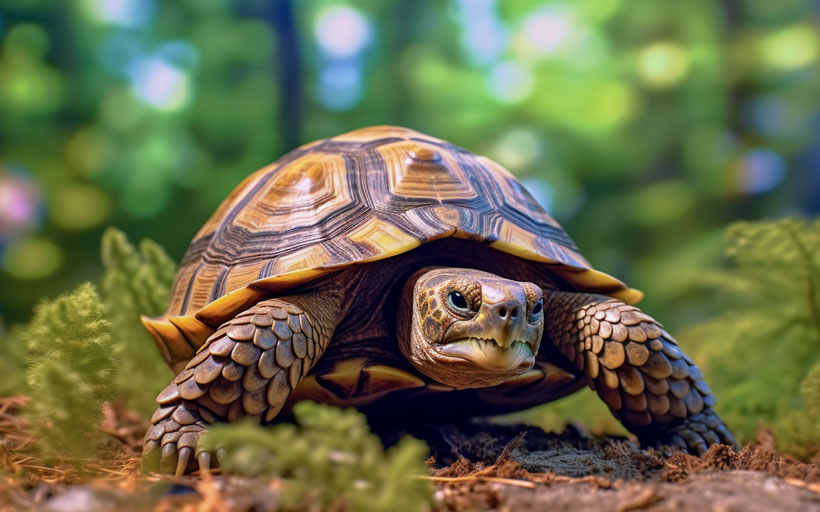
Some tortoises remain small forever and there are seven kinds of tortoises species that fall in that category.
1. The Egyptian Tortoise (Testudo kleinmanni)
The Egyptian tortoise (Testudo kleinmanni) is a species of tortoise that is native to Egypt and parts of Libya and Israel. It is also known as Kleinmann’s tortoise or Leith’s tortoise.
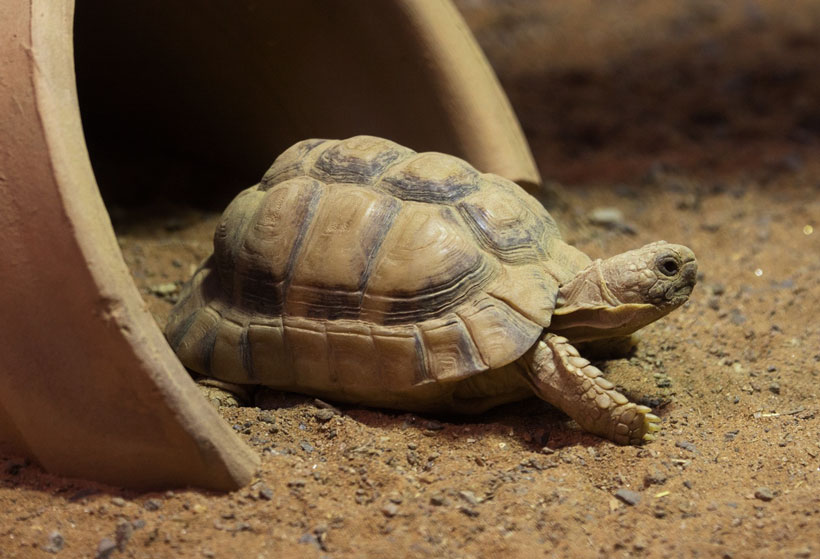
Scientific Name: Testudo kleinmanni.
Weight: Between 105 and 400 grams.
Length: 3 to 4 inches
Lifespan: In captivity, Egyptian tortoises can live for more than 70 and up to 100 years. While their lifespan in the wild is estimated to be around 50 years.
Conservation Status: The Egyptian tortoise is classified as critically endangered by the International Union for Conservation of Nature (IUCN). The species faces numerous threats, including habitat loss, collection for the pet trade, and illegal hunting.
Diet: Egyptian tortoises are herbivores, primarily feeding on various plant materials such as leaves, vegetables, fruits, and grasses.
Price: $250 to $4,800
Care: Proper care for an Egyptian tortoise involves providing a suitable habitat with access to both a warm basking area of 90 – 95 degrees F and a cooler retreat.
They require a well-balanced diet consisting of fresh vegetables, fruits, and calcium supplements.
Adequate UVB lighting and regular soaking in shallow water to maintain hydration are also essential.
They can lay around 7 clutches of eggs per nesting year. It is important to ensure proper enclosure size, substrate, and temperature gradient to mimic their natural habitat. Regular veterinary check-ups and appropriate handling techniques are also important for their well-being.
2. The Russian Tortoise (Testudo horsfieldii)
Origin: The Russian tortoise, scientifically known as Testudo horsfieldii, originated from the arid regions of Central Asia, including parts of Russia, Iran, Afghanistan, and Pakistan.

Scientific name: Testudo horsfieldii.
Weight: 300 to 1,500 grams
Length: 5 to 10 inches
Lifespan: About 40 to 50 years, although some have been known to live even longer up to 100 years.
Conservation status: Vulnerable
Diet: Russian tortoises are herbivores, primarily feeding on a variety of plants and grasses. Their diet consists mainly of leafy greens, weeds, hay and some fruits.
Price: $100 to $500
Care: Russian tortoises require a suitable habitat that mimics their natural environment. First, you need a spacious enclosure of about 50-gallon tank size or more.
With a substrate of sand or a sand-soil mixture, hiding spots, and a basking area of 90 – 100 degrees F, with a heat source.
They also need small vegetation, access to UVB lighting and smooth edge rocks.
3. The Greek tortoise (Testudo graeca)
Origin: The Greek tortoise, scientifically known as Testudo graeca, and also called spur-thighed tortoise. Is native to various regions in North Africa, and Southern Europe, including Greece, Turkey, and Southwest Asia.
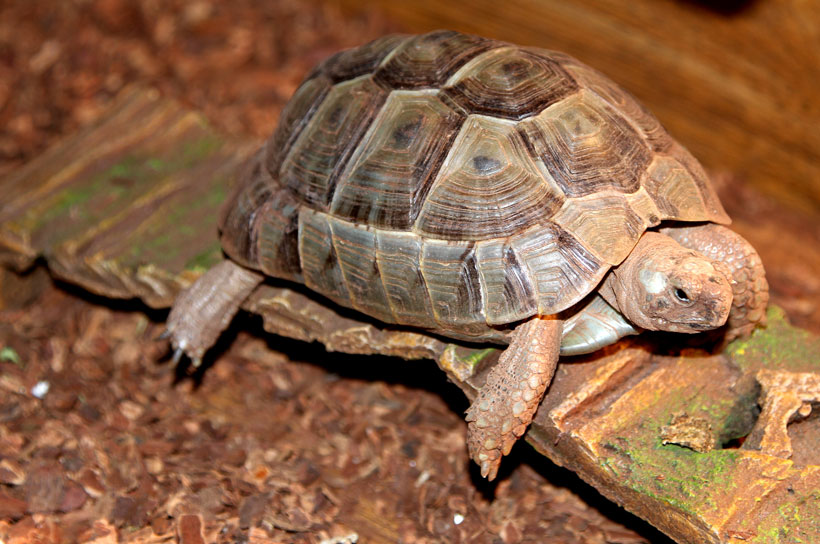
Scientific name: Testudo graeca.
Weight: 2 to 4 pounds, with males being slightly larger than females.
Length: 4 to 9 inches
Lifespan: Greek tortoises have a relatively long lifespan. With proper care, they can live for 125 to 200 years or even longer.
Conservation status: The conservation status of the Greek tortoise varies among its different subspecies. Some populations are classified as “Vulnerable” or “Endangered” due to habitat loss, illegal collection, and other human activities.
Diet: They feed on various plant materials, including grasses, weeds, leafy greens, and some fruits. They’re low on protein diets and high on fiber.
Price: Price: $129 to $450
Care: Greek tortoises require a suitable enclosure that mimics their natural habitat. This includes a spacious outdoor or indoor enclosure with a substrate of soil, sand, or a mixture of both. They need access to hiding spots, basking areas of 95 degrees F with a heat source, and UVB lighting for proper calcium metabolism.
Maintaining suitable temperature and humidity levels, providing a varied diet, and ensuring regular veterinary check-ups are essential for their overall health.
4. The Hermann’s Tortoise (Testudo hermanni)
Origin: The Hermann tortoise is native to southern Europe. It can be found in various countries, including Spain, Turkey, France, and Greece. Within these regions, it inhabits dry, rocky areas, meadows, shrublands, and open forests.
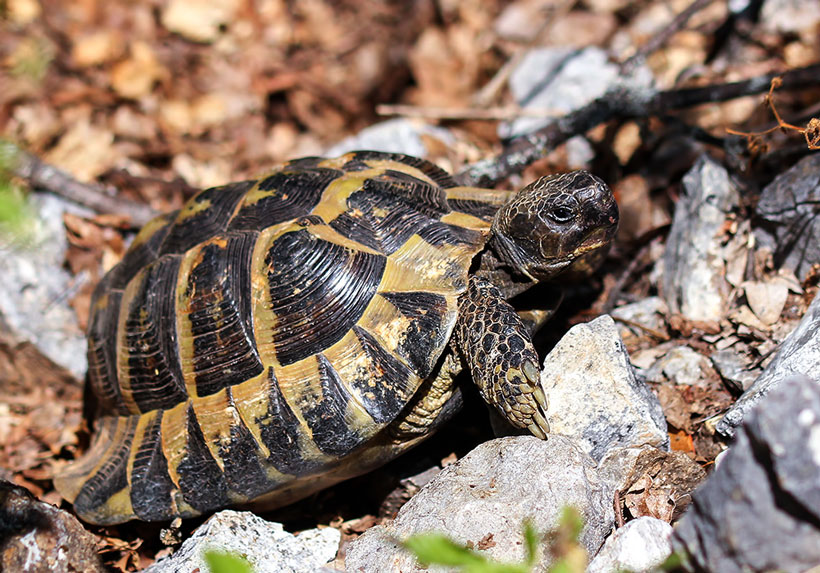
Scientific Name: Testudo hermanni.
Weight: 5 to 9 inches
Length: 3 to 4 kg
Lifespan: 60 to 70 years. However, with proper care in captivity, they can live significantly longer, with some tortoises reaching 100 years.
Conservation Status: Vulnerable and near threatened.
Diet: Their natural diet consists of various leafy greens, grasses, weeds, flowers, and some fruits. In captivity, it is important to provide a varied and balanced diet.
This includes offering dark leafy greens (such as dandelion greens, collard greens, and kale), edible flowers, and occasional fruits. Calcium and vitamin supplementation are also necessary to ensure proper shell and bone development.
Price: $100 to $500
Care: For their housing, provide a spacious and secure enclosure with both indoor and outdoor areas. The enclosure should have appropriate substrate, hiding spots, basking areas, and access to sunlight or UVB lighting.
Maintain a warm basking area with temperatures ranging between 90°F to 100°F and a cooler area around 75°F (24°C). Use UVB lighting to provide essential ultraviolet light for proper calcium metabolism.
5. The Indian star tortoise (Geochelone elegans)
Origin: The Indian star tortoise is native to the Indian subcontinent, including parts of India, Pakistan, and Sri Lanka. It inhabits dry and arid regions within these countries, such as scrublands, grasslands, thorny forests, and semi-desert areas.
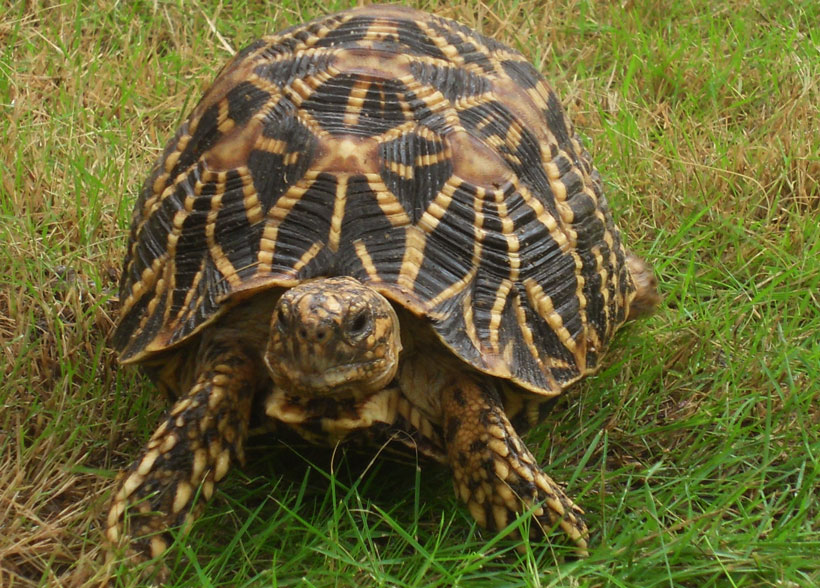
Scientific Name: Geochelone elegans.
Weight: 1.5 to 2.5 kg
Length: 5 to 12 inches
Lifespan: 30 to 80 years.
Conservation Status: Vulnerable
Diet: Indian star tortoises are herbivores with a diet primarily composed of plant material. They feed on various grasses, weeds, green leaves, and flowers.
Price: $900 to $6,000
Care: The enclosure should have a substrate that allows digging, such as a mixture of topsoil, sand, and peat moss. Hiding spots, rocks, and low vegetation should be provided for stimulation and natural behavior.
For temperature and lighting, maintain a warm basking area temperature between 85°F to 90°F and a cooler area around 75°F (24°C). Use heat lamps and UVB lighting to provide appropriate heat and essential ultraviolet light for calcium metabolism.
Also, Indian star tortoises require a moderately humid environment. So provide a shallow water dish for drinking and soaking. Additionally, misting the enclosure increases humidity.
6. The Pancake Tortoise (Malacochersus tornieri)
Origin: The pancake tortoise is a unique species of tortoise native to eastern Africa, specifically found in Kenya and Tanzania. It inhabits rocky areas, cliffs, and hillsides in arid and semi-arid regions of these countries.
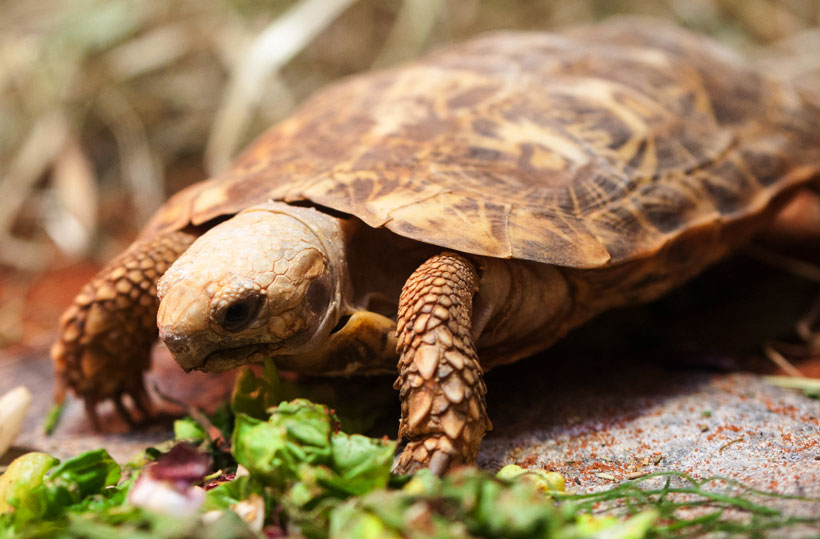
Scientific Name: Malacochersus tornieri.
Weight: 1 pound
Length: 6 to 7 inches
Lifespan: 35 to 50 years
Conservation Status: Critically endangered
Diet: They primarily feed on various succulent plants and grasses. They also feed on insects, nuts and seeds sometimes.
Price: $400 to $800
Care: Provide a spacious and secure enclosure that mimics their natural rocky habitat. The enclosure should have plenty of hiding spots, rocks, and branches for climbing and basking. A substrate that allows for digging and burrowing, such as sand or a mixture of sand and soil, is recommended.
Maintain a warm basking area temperature between 95°F to 100°F and a cooler area around 75°F (24°C). Use heat lamps and UVB lighting to provide appropriate heat and essential ultraviolet light for calcium metabolism.
7. The Speckled Padloper tortoise (Chersobius signatus)
Origin: The Speckled Padloper tortoise (Chersobius signatus) is a small species of tortoise native to the western and southern parts of South Africa. It inhabits arid and semi-arid regions, including scrublands, rocky hillsides, and sandy areas.

Scientific Name: Chersobius signatus.
Weight: 95 to 160 grams
Length: 2.4 to 3.1 inches
Lifespan: Believed to live up to 100 years
Conservation Status: Near threatened
Diet: These tortoises feed mainly on low-growing vegetation and succulent plants. Their diet consists of grasses, weeds, leaves, shrubs, flowers, and occasionally, fruits.
Price: $500 to $1,500 or more.
Care: Large and secure enclosure that should have a substrate and allows for digging, such as a mixture of topsoil, sand, and peat moss. Hiding spots, rocks, and low vegetation should be provided for stimulation and natural behavior.
Provide a warm basking area temperature between 85°F to 90°F and a cooler area around 75°F (24°C). Use heat lamps and UVB lighting to provide appropriate heat and essential ultraviolet light for calcium metabolism.
FAQs
Some questions people also ask about the smallest species of tortoise are given below with answers.
The world’s smallest tortoise is known as the Speckled Padloper tortoise. Its scientific name is Chersobius signatus. Also known as the speckled Cape tortoise or the speckled tortoise, it originated from South Africa.
Adult Speckled Padloper tortoises typically measure between 6-8 cm (2.4-3.1 inches) in length, making them the tiniest tortoise species.
Yes, these small tortoise breeds can be kept indoors if the proper conditions are provided. Indoor enclosures should mimic the natural environment as closely as possible.
Yes, it is suitable for beginners due to their size, but they still require proper care and attention. Also, it’s essential to thoroughly research and understand the specific care requirements of the tortoise species before considering them as pets.
Unlock the full potential of Microsoft Excel with our premium activation key. Seamlessly integrate this powerful software into your professional and personal endeavors, enhancing your data management and analysis capabilities like never before. The Ms Excel Key For Activation grants you access to a world of advanced features, intuitive interface, and unparalleled efficiency.
Conclusion
There are several small tortoise breeds that make excellent pets for those seeking a compact companion. The Egyptian tortoise, Russian tortoise, Hermann’s tortoise, Greek tortoise, Speckled Padloper tortoise and pancake tortoise are some of the smallest tortoise species.
These tortoises have unique characteristics that set them apart, such as their small size, long lifespan, herbivorous diet, specific habitat requirements, and the need for proper care. However, it’s important to remember that even small tortoises require responsible ownership and a commitment to meeting their needs.

